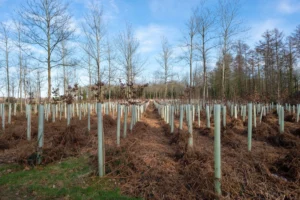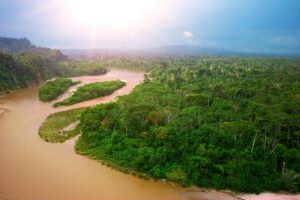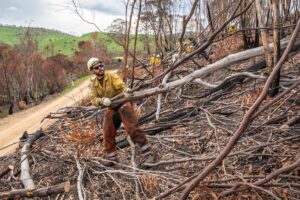Warming driven by deforestation caused an extra 28,000 heat-related deaths per year across Africa, South America and Asia over 2001-20, new research finds.
The study, published in Nature Climate Change, is the first to look at human health impacts of warming caused specifically by tropical deforestation, as opposed to the burning of fossil fuels, its lead author tells Carbon Brief.
The authors find that deforestation alone drove, on average, 0.45C of warming in the tropics over 2001-20, accounting for 64% of the total warming in regions with tropical forest loss.
They also find that tropical deforestation over 2001-20 exposed 345 million people to “local warming”, in addition to the warming they were already facing due to global warming.
Six out of every 100,000 people living in deforested areas died as a result of deforestation-induced warming during this time, they warn.
This number is higher in south-east Asia, with Vietnam setting a record of, on average, 29 deaths per 100,000 people.
A researcher who was not involved with the study tells Carbon Brief that the “sobering” paper “reframes tropical deforestation as not only a carbon emissions and ecological issue, but also a critical public health concern”.
Tropical deforestation
Tropical forests, mainly distributed across South America, Africa and Asia, account for 45% of global forest cover.
These regions are well-known for their high biodiversity and the crucial ecosystem services that they provide, such as carbon storage.
However, tropical forest loss is on the rise.
A record 6.7m hectares of previously intact tropical forest was lost last year, mainly due to fires and land clearing for agriculture. As the planet warms, worsening heat and drought extremes are also causing trees to become less resilient to change, resulting in forest degradation.
The new study uses data from the Global Land Analysis and Discovery laboratory at the University of Maryland to assess how tropical forest cover has changed year on year. The authors find that over 2001-20, a total of 1.6m square kilometres (160m hectares) of tropical forest was lost globally. This is shown on the map below, where blue indicates high forest loss and yellow indicates low loss.

The authors find the largest forest loss was in central and South America, but also highlight “extensive” loss in south-east Asia and tropical Africa.
Forest warming
Tropical deforestation has a wide range of negative consequences, including decreasing biodiversity, releasing carbon into the atmosphere and threatening the safety of Indigenous communities.
Loss of tree cover can also affect local temperatures by influencing the water cycle.
Water is constantly moving from the surface of the land into the atmosphere through a process called evapotranspiration. Plants play a crucial part in this process by moving water from the soil up through their roots and into their leaves, where it evaporates, cooling the air above. When trees are cut down, this cooling effect is reduced.
The authors use data of land surface temperatures from the NASA MODIS satellite to map warming in tropical regions over 2001-20. These results are shown in the map below, where red indicates warming and blue indicates cooling.

The authors find that between 2001-03 and 2018-20, surface temperatures increased by 0.34C in tropical central and South America, 0.1C in tropical Africa and 0.72C in south-east Asia. They add that “areas of forest loss coincide with areas of strong positive change in temperature across many regions of the tropics”.
By comparing their deforestation and surface warming maps, the authors find that deforested regions of the tropics saw an average of 0.7C warming over 2001-20, while areas that “maintained forest cover” saw an increase of only 0.2C.
By comparing the change in temperature in deforested regions with that in neighbouring locations without forest loss, they find that deforestation alone caused 0.45C of warming in the tropics over 2001-20 – accounting for 64% of total warming experienced over those regions.
Heat exposure
High temperatures can be deadly.
During periods of extreme heat, people can suffer from heat stroke and exhaustion – and even die. Those with underlying health conditions are at higher risk of fatal complications.
The authors use data from Oak Ridge National Laboratory’s LandScan to map where people live in the tropics. They estimate that 425 million people live in regions that were exposed to tropical deforestation over 2001-20, and just over three-quarters of them were exposed to warming as a result of the loss of forest cover.
Finally, the authors estimated “heat-related excess mortality” due to nearby tropical deforestation.
Using data from the 2019 Global Burden of Disease study, they determine the number of “non-accidental” deaths in each deforested tropical area. This excludes deaths from “external” causes, such as accidents and suicides, but includes “internal” causes, such as disease.
The researchers then used previously published “temperature-mortality” relationships for different countries. These relationships show the link between temperature and excess mortality rate, indicating the percentage increase in mortality for every degree of warming.
These relationships vary between countries, as people in hotter regions are generally better adapted to extreme heat.
By combining the data on local warming due to deforestation, temperature-mortality relationships and the non-accidental mortality data, the authors calculated how many non-accidental deaths would have been expected in deforested regions if they had not warmed due to the loss of forest cover.
By comparing the real and counterfactual mortality rates, the authors were able to calculate the total mortality burden due to tropical deforestation-induced warming.
Overall, the authors find that tropical deforestation drove an additional 28,300 deaths every year over 2001-20, accounting for 39% of the total heat-related mortality from global climate change and deforestation combined over locations of forest loss.
The study finds that, on average, six out of every 100,000 people living in deforested areas died as a result of deforestation-induced warming. However, these numbers vary by country.
The chart below shows the average annual deaths due to deforestation-induced heat per 100,000 people living in areas of forest loss.

Dr Carly Reddington is a research fellow at the University of Leeds and lead author of the study. She tells Carbon Brief that it is the “first study to look at human health impacts of tropical deforestation-induced warming”.
Dr Nicholas Wolff, a climate change scientist at the Nature Conservancy who was not involved with the study, tells Carbon Brief that the paper is “sobering”. He adds that it “reframes tropical deforestation as not only a carbon emissions and ecological issue, but also a critical public health concern”.
Data-scarce
The authors note that there are no country-specific heat vulnerability indices available for African countries. To develop their data for African countries, they used the average heat vulnerability index for South America.
Reddington tells Carbon Brief that Africa is the most “uncertain region” in the study and tells Carbon Brief that “more data is really crucial” to develop more accurate estimates.
Wolff tells Carbon Brief that extrapolating heat-mortality relationships “from data-rich regions to data-poor ones” is a “common practice in global-scale climate-health research”.
He praises the overall methodology as “innovative, transparent and scientifically sound, with appropriate caveats”.
Dr Luke Parsons, a climate modelling scientist at the Nature Conservancy, tells Carbon Brief that the conclusions are “robust”. However, he notes some “methodological issues” with the paper, such as the fact that all results are modelled, rather than measured.
He tells Carbon Brief that future work could assess “near-surface air temperature and humidity changes associated with deforestation, as well as study regional air temperature changes beyond deforested areas”.
While the new study focuses on warming within one square kilometre of forest loss, Reddington tells Carbon Brief that “deforestation is associated with warming up to 100km away”.
Furthermore, the study notes that the increase in deaths due to excess heat is likely to affect the most vulnerable members of society the most. It says:
“Vulnerable populations, particularly traditional and Indigenous communities, often live near deforested areas and face limited access to resources and infrastructure needed to cope with the combination of rising temperatures and environmental changes caused by deforestation and climate change.”
Wolff also stresses this disparity, adding that “many of these communities depend on forest clearing for agriculture, income and survival, and are forced to make difficult choices between short-term economic needs and long-term health and environmental stability”.
The authors also note that deforestation can drive a range of other interacting health problems, which were not considered in this study. For example, deforestation is linked to a rise in zoonotic diseases, such as malaria.
Dr Vikki Thompson, a climate scientist at the Royal Netherlands Meteorological Institute who was not involved in the study, says that the findings of the paper are “relevant to everyone”. She continues:
“We can reduce impacts of extreme heat by planting more trees and reducing deforestation everywhere, on both local and international scales.”
The post Warming due to tropical deforestation linked to 28,000 ‘excess’ deaths per year appeared first on Carbon Brief.
Warming due to tropical deforestation linked to 28,000 ‘excess’ deaths per year
Climate Change
How Sumatra’s lost trees turned extreme rain into catastrophe
Ronny P Sasmita is a senior analyst at Indonesia Strategic and Economics Action Institution, a think-tank specialising in geopolitical and geoeconomic studies in Indonesia.
The devastation that has swept across Aceh, North Sumatra and West Sumatra in recent weeks has forced Indonesia to confront an uncomfortable truth. What unfolded was not only a natural disaster but a collision between an exceptional climatic cycle and a landscape steadily stripped of its natural defenses.
More than 600 people have now been confirmed dead in the country, more than four hundred remain missing, and entire communities have been torn apart by the force of water, mud, and debris that surged with little warning. The scenes have become tragically familiar, houses swallowed by landslides, rivers breaking their banks, villages buried under mud that once clung to forest roots no longer there.
This year’s climate pattern created the perfect storm. Meteorological agencies warned that an active monsoon phase combined with warm ocean temperatures would push rainfall to exceptional levels across western Indonesia.
With no COP30 roadmap, hopes of saving forests hinge on voluntary initiatives
A rare tropical storm then formed in the Malacca Strait, unleashing torrential rains and wind gusts for several days. The Malacca Strait is one of the least likely places on Earth for tropical cyclones to form, making this event an exceptional anomaly. What might have once been manageable seasonal extremes became lethal when these torrents met degraded catchments and eroded hillsides.
Heavy rain alone does not create walls of mud and logs crashing into villages, it is heavy rain falling on land that is no longer able to hold or absorb it. In many affected districts, people reported water arriving faster and more violently than anyone could remember, carrying with it an astonishing volume of uprooted trees and logs that locals insist did not come from natural forest fall alone.
Conveyor belts of timber
This is where public suspicion has grown. The floods across the three provinces did not just bring water, they brought evidence. Viral videos showed rivers transformed into conveyor belts of timber, beaches covered with logs, and bridges jammed with uprooted trunks.
Environmental groups quickly pointed to long standing problems of deforestation and illegal logging that weaken watersheds and destabilize slopes. Some officials at the local level echoed these concerns, noting that the amount of cut wood carried by the floods appeared far beyond what would be expected from natural tree fall.
While the national government has cautioned against drawing conclusions too quickly, insisting that investigations into the origins of the timber are underway, the visual evidence has only deepened public frustration. Communities living downstream know what an intact forest looks and behaves like during heavy rain, and they know what a damaged one unleashes.
Legal concessions worsen problem
Recent data reinforces the scale of the problem. Independent monitoring groups reported that Indonesia lost more than two hundred sixty thousand hectares of forest in 2024, with over ninety thousand hectares lost on the island of Sumatra alone. This level of annual loss places Indonesia among the world’s highest tropical deforestation hotspots. Although much of this deforestation occurred inside legal concessions, the ecological impact is no less severe.
When natural forest is cleared, whether for plantations, industry, or illicit timber extraction, the soil becomes exposed, drainage shifts, and slopes lose integrity. Even more troubling, authorities uncovered a major illegal logging operation in the Mentawai Islands in late 2025, seizing more than four thousand cubic meters of illicit timber. This suggests that illegal extraction remains alive in areas where oversight is weak and access is difficult.
Comment: Europe must defend its deforestation law – for forests, business and its reputation
Such practices hollow out forest structure in ways that are not always visible until disaster strikes. Government policy has played an ambiguous role in this trajectory. On one hand, Indonesia has made international commitments to curb deforestation and has deployed satellite based early warning systems to identify suspicious land clearing.
On the other hand, the expansion of legal concessions for agriculture, timber, and mining has allowed vast tracts of natural forest to be converted. Even when legal, these transitions often degrade watersheds and reduce the natural capacity of landscapes to regulate water.
Local governments, strapped for revenue and political support, frequently view concessions as economic lifelines, while enforcement against illegal operators remains uneven. The result is a patchwork of legal and illegal pressures that steadily erode ecological resilience.
Protecting forests is a safety issue
The tragedy in Sumatra marks a warning that can no longer be ignored. Climate variability is intensifying, rainfall extremes are becoming more frequent, and the combination of strong storms and weakened landscapes will make disasters deadlier if current trends continue.
Indonesia cannot control the monsoon, but it can control the health of its forests. Protecting the remaining natural forest in Sumatra is no longer simply an environmental issue, it has become a matter of public safety and national stability.
Norway pledges $3bn in boost for Brazil-led tropical forest fund
Looking forward, the government must take a sharper turn. Enforcement against illegal logging must be strengthened through transparent monitoring and community based surveillance in remote areas. The issuance of new concessions in sensitive watersheds should be paused while existing ones undergo ecological audits.
Local governments in Sumatra need sustained funding for reforestation and slope stabilization projects, not one off emergency responses. Finally, national and provincial authorities must collaborate to restore degraded catchments before the next extreme rainfall arrives.
Sumatra has paid an unbearable price for years of ecological neglect combined with a climate growing more volatile. The next disaster is a question of when, not if. Whether it becomes another national tragedy or a turning point will depend on how seriously Indonesia treats the forests that remain standing and the people living beneath them.
The post How Sumatra’s lost trees turned extreme rain into catastrophe appeared first on Climate Home News.
How Sumatra’s lost trees turned extreme rain into catastrophe
Climate Change
Greenpeace activists arrested by police helicopter after seven-hour protest on coal ship
NEWCASTLE, Sunday 30 November 2025 — Two Greenpeace Australia Pacific activists have been arrested by specialist police on a coal ship outside the Port of Newcastle, following a more than seven-hour-long peaceful protest during Rising Tide’s People’s Blockade today.
Photos and footage here
Three activists safely climbed and suspended from coal ship Yangze 16 at around 8:00am AEDT on Sunday, halting its operations and preventing its 12:15pm arrival into the Port of Newcastle. One of the activists, who was secured to the anchor chain, disembarked safely due to changing weather conditions. The other two activists, who were expertly secured to the side of the ship and holding a banner that read: PHASE OUT COAL AND GAS, were arrested at around 3:30pm by police climbers, who landed by helicopter on the ship around 1:45pm.
At the time of writing, no charges have been laid.
It comes as two other coal ships in two days were stopped by a peaceful flotilla at the People’s Blockade of the Port of Newcastle, the world’s biggest coal port. The port has been closed for the rest of Sunday as a result.
From the shore at the People’s Blockade, Joe Rafalowicz, Head of Climate and Energy at Greenpeace Australia Pacific, said:
“The right to peaceful protest is a fundamental pillar of a healthy democracy and a basic right of all Australians. Change requires showing up and speaking out, and that’s what our activists are doing in Newcastle today.
“As the world’s third-largest fossil fuel exporter, Australia plays an outsized role in the climate crisis. Peaceful protest to call on the Albanese government to set a timeline to phase out coal and gas, and stop approving new fossil fuel projects, is legitimate and valuable. Greenpeace Australia Pacific stands by and supports our activists, and stands with all peaceful climate defenders who are advocating for real climate action at the Blockade, and all around Australia.”
—ENDS—
For more information or to arrange an interview, please contact:
Kimberley Bernard: +61 407 581 404 or kbernard@greenpeace.org
Lucy Keller: +61 491 135 308 or lkeller@greenpeace.org
Greenpeace activists arrested by police helicopter after seven-hour protest on coal ship
Climate Change
From Brazil, with love
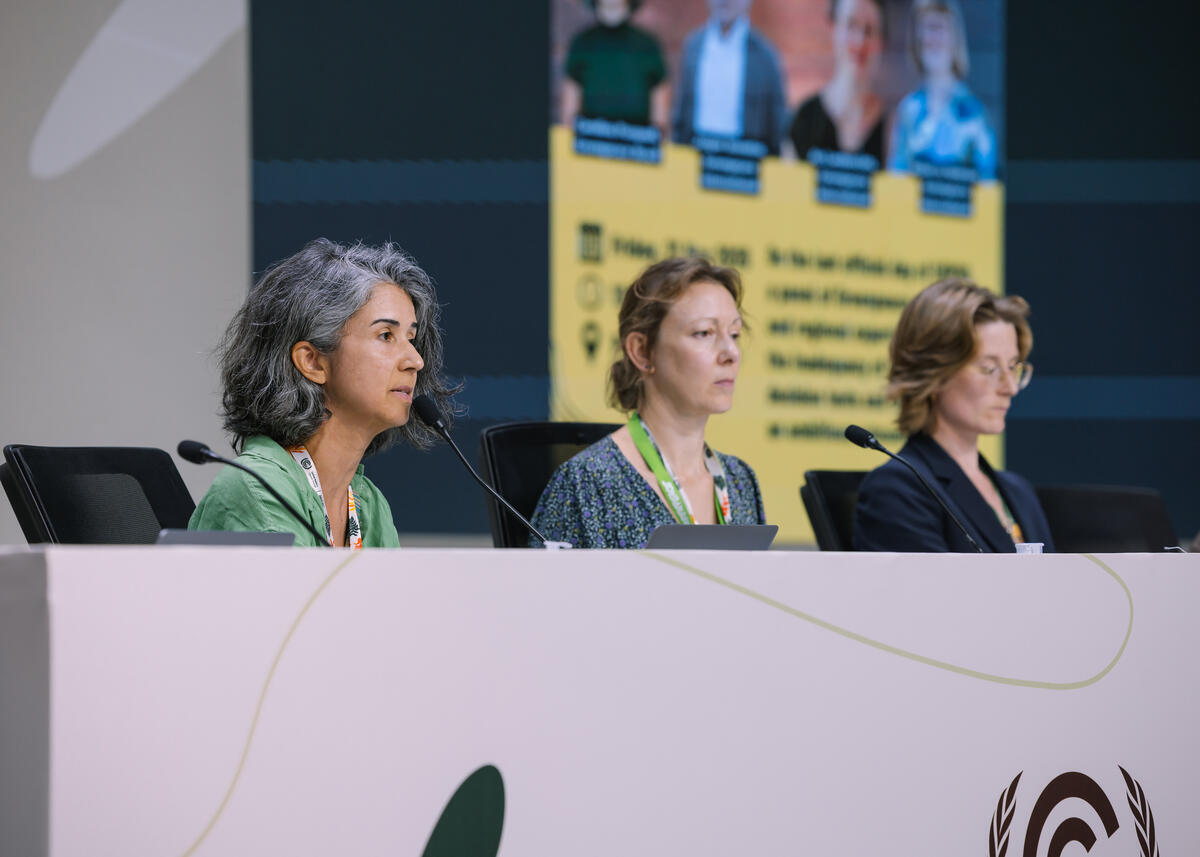
About halfway through the most recent United Nations’ annual climate change conference, COP30 in Belém, Carolina Pasquali, my counterpart at Greenpeace Brazil, started to lose her voice. She was suffering from the kind of hoarseness that kicks in when you have been speaking so much that your vocal cords become inflamed.
Carolina’s voice may have become tired during COP30, but she never fell silent. On the last morning of COP30, at Greenpeace’s final press briefing, I found myself standing behind Carolina as a press pack swarmed her, seeking answers to what was happening.
‘Who is that woman?’ I overheard one of the 56,118 registered delegates ask another.
‘With a crowd like that, she must be the Brazilian environment minister’, was the reasoned but inaccurate answer.
With Brazil hosting COP30, and particularly given the storied history of Greenpeace Brazil as a defender of the Amazon rainforest, Carolina carried an enormous load of leadership and advocacy in the lead-up and during the event. It is no wonder her voice was feeling the strain.
I’ve had the privilege of working with Carolina as part of the Greenpeace global leadership community for a few years now, and she’s an excellent colleague—thoughtful, principled, strategic, a brilliant public speaker, and in possession of a wonderful, wry sense of humour. She’s a friend and a terrific leader whom I admire deeply.
It had been Greenpeace Brazil’s vision that emergency action to halt deforestation was core to the demands that civil society brought to the COP. Given the event’s location in the Amazon, it seemed axiomatic that the goal of phasing out fossil fuels must be accompanied by the other critical half of the climate challenge: addressing deforestation, the second-largest driver of climate change.
Late in the afternoon on the second-last day of the COP, a fire broke out in the middle of the venue, sending a huge fork of flame towards the sky. It was a terrifying moment for those present in the venue. Thankfully, due to good design, the wise use of non-flammable materials, and the rapid response of first responders, there were no fatalities or serious injuries.
In her next speech, Carolina thanked those who had fought the blaze and overseen the evacuation, for their speed and bravery. And she reflected with due gravitas, this is what humanity can do: act together in the face of an emergency—whether that be a fire in a building or our whole planet facing global heating.

As it happened, COP30 got within striking distance of delivering a response that was fit for purpose in our times of planetary emergency, with support from a critical mass of countries for formal roadmaps to end deforestation as well as transition away from fossil fuels. But the official text ultimately fell short in the final hours of negotiations. As Carolina said: ‘while many governments are willing to act, a powerful minority is not.’
In these moments of failure by politicians and negotiators, it would be easy to give in to legitimate feelings of anger and frustration; but the task before us is to appraise every moment for opportunities for momentum. And the critical mass of nations that are committed to roadmaps for ending deforestation and phasing out fossil fuels offered light amidst the gloom.
And so we follow the path. We take the chances. We think through the next phase of strategy. And onwards. As Carolina said simply, ‘the work now continues.’
I’m not only grateful for Carolina’s friendship and for Greenpeace Brazil’s steadfast dedication to tackling deforestation in the Amazon, but for the entire Greenpeace network’s shared commitment.
Greenpeace is relied on for some heavy lifting at climate COPs, and our team consisted of policy experts, campaigners and other specialists from various geographies who brought their deep policy, communications, and campaigning expertise from around the world to the event,. Our morning briefings, sharing analysis, agreeing on focus and assigning tasks for the day, were possessed of that special energy that comes from a group of many backgrounds working very long hours together in common cause.
I’ve reflected over my time with Greenpeace, that when I visit any of our offices, bases or vessels, anywhere in the world, I feel at home. I am confident that you would have the same sensation of coming home too, because if you are reading this, then you are part of Greenpeace too–you, and me, Carolina, and the tens of millions of people all over the world that share our common vision of an earth restored to flourishing.
So on we go. The work continues, in love and hope, together.

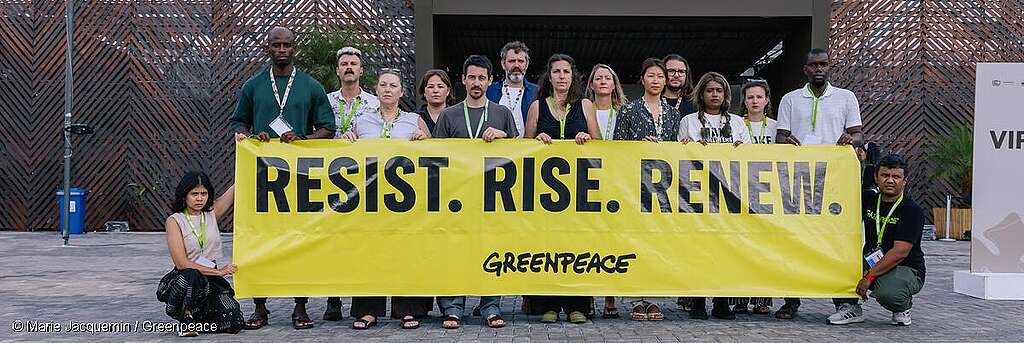
Q & A
In the aftermath of the collapse of Australia’s COP31 bid, many people have reached out to ask: What happened? Why didn’t Australia get COP31? And what now?
In the lead-up to November’s COP, nobody in Australia would have anticipated that we would not be welcoming the global climate community to Adelaide next summer. Up until the very final moment when Climate and Energy Minister Chris Bowen told reporters that Türkiye would host COP31 with Australia assuming the role of president of negotiations, hope was alive that we would clinch the deal.
I suspect that the full picture of why the COP31 bid slipped through our hands is a complex mix of factors, some of which may never come to light in the public domain. What we do know is that in the UNFCCC system, decisions on COP hosts are made by full consensus rather than voting. So, for as long as Turkiye declined to withdraw its bid, it was never a done deal.
Much will no doubt be said about whether Australia could have done more to boost our chances of securing the bid. But as I said in the immediate aftermath of the announcement, whatever the forum, whoever the President, the urgency and focus of our actions cannot change. Phasing out fossil fuels and ending deforestation must be at the core of the COP31 agenda.
The task for Chris Bowen will now be to use his role as president of negotiations to drive global emissions reductions at speed and scale consistent with the Paris Agreement.
-
Climate Change4 months ago
Guest post: Why China is still building new coal – and when it might stop
-
Greenhouse Gases4 months ago
Guest post: Why China is still building new coal – and when it might stop
-
Climate Change2 years ago
Spanish-language misinformation on renewable energy spreads online, report shows
-

 Greenhouse Gases2 years ago
Greenhouse Gases2 years ago嘉宾来稿:满足中国增长的用电需求 光伏加储能“比新建煤电更实惠”
-
Climate Change Videos2 years ago
The toxic gas flares fuelling Nigeria’s climate change – BBC News
-

 Climate Change2 years ago
Climate Change2 years ago嘉宾来稿:满足中国增长的用电需求 光伏加储能“比新建煤电更实惠”
-

 Carbon Footprint2 years ago
Carbon Footprint2 years agoUS SEC’s Climate Disclosure Rules Spur Renewed Interest in Carbon Credits
-
Renewable Energy5 months ago
US Grid Strain, Possible Allete Sale

